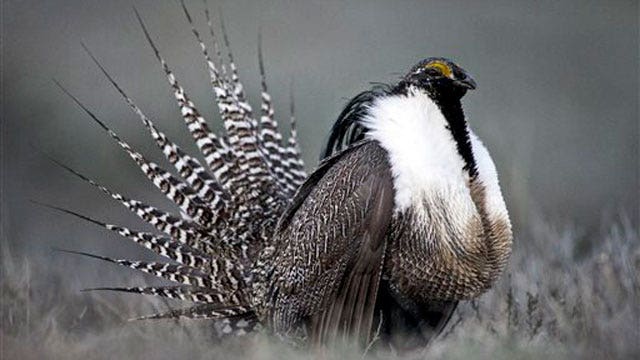A small, chicken-like bird is threatening economies across the American West as the feds weigh new regulations to protect it.
Meet the sage grouse. The animal stands at the center of the latest battle pitting America's domestic energy industry against conservationists trying to protect a little-known species from harm. Like past clashes over the spotted owl or a desert-dwelling pronghorn, the results could be costly.
The federal government already listed one variety of the bird, the Gunnison sage grouse, as threatened under the Endangered Species Act earlier this month, prompting Colorado to prepare a lawsuit over the decision.
But that bird only thrives in western Colorado and eastern Utah. The feds continue to weigh a far more expansive listing of its cousin, the greater sage grouse. That bird lives in 11 western states, and an endangered species listing could have a much bigger economic impact.
"There's extensive energy development, mining, recreation, ranching, farming," said Kathleen Sgamma, with the Western Energy Alliance. "And sage grouse restrictions that really aren't tailored to actual conditions on the ground could kill jobs and economic activities in rural communities across the West."
In 2010, the U.S. Fish and Wildlife Service first determined that an endangered species listing was warranted for the greater sage grouse. Budget problems forced the agency to put off a final decision until 2015.
No one doubts the bird is in trouble. "The greater sage grouse has been declining for at least 50 years," said wildlife biologist Erik Molvar, who runs environmental group Wild Earth Guardians' campaign to save the bird.
"In the 1800's there were probably more than 16 million of these birds," Molvar said. Fish and Wildlife now estimates the population at between 200,000 and a half-million. The birds depend on eating sagebrush leaves for survival, but the territory has been shrinking -- and human activity interferes with the bird's ability to mate and nest.
Still, states in the region are extremely concerned about the economic impact of a federal listing.
"In Wyoming, the sage grouse territory is about 80 percent of the state," said Wyoming Gov. Matt Mead, whose state is the biggest energy exporter in the country.
The governor argues that an endangered species would hurt the entire country. "We're not going to survive if we don't have energy and we don't have food and we don't have the ability for municipalities to grow and prosper."
Molvar and others contend that energy development is a key reason the grouse numbers have declined in Wyoming, Montana and Colorado. "This heavy amount of drilling activity and the industrial incursions into these sage grouse habitats fragment the habitat into smaller and smaller patches and cause disturbance that drive the sage grouse out," Molvar said.
Pat Deibert, the national sage grouse conservation coordinator with the U.S. Fish and Wildlife Service, said “previous determinations have found that energy development is a significant negative factor for the sage grouse."
But Mead notes that fossil fuel production would not be the only type of energy affected, and that wind farms and solar power installations could also face “conflicts.”
For Sgamma, the issue evokes memories of a past fight, over the spotted owl, whose listing "wiped out" timber communities. Yet the range of the spotted owl is small compared with that of the greater sage grouse, whose territory totals 165 million acres, a combined land area almost the size of Texas.
States like Wyoming are working hard to save the greater sage grouse on their own. "I think we've spent ourselves about 35 million dollars trying to get in a position so the bird is not listed,” Mead said. Wyoming's plan prohibits human activity for more than a half-mile around the grouse's annual mating and nesting areas.
Molvar, though, says the plan doesn't do enough and believes an endangered species listing must happen to save the bird.
While Deibert applauds Wyoming for being proactive in trying to conserve the bird, she cautions that its effort alone will not be enough to keep the bird from being listed. "Our decision is going to be made based on the range-wide analysis of the greater sage grouse, not just the sage grouse in the state of Wyoming. We have to look at the 10 remaining states as well as our Canadian provinces to see what the conservation actions have been."





